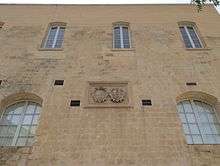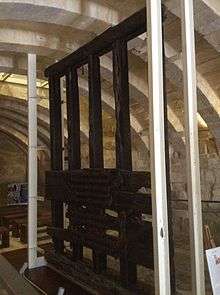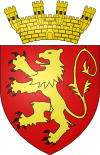Fortifications Interpretation Centre
 | |
 | |
| Established | 16 February 2013 |
|---|---|
| Location | Valletta, Malta |
| Coordinates | 35°53′58″N 14°30′33″E / 35.89944°N 14.50917°E |
| Type | Interpretation centre |
| Curator | Stephen C. Spiteri |
| Owner | Government of Malta |
| Website | Official website |
The Fortress Builders – Fortification Interpretation Centre (FIC) is an interpretation centre about the fortifications of Malta. It is housed in a late 16th-century warehouse located near the St. Andrew's Bastion in Valletta, Malta. The centre was opened in 2013, and it aims at communicating Malta's military architecture in an interactive way.
The building was formerly known as the Biagio Steps Examination Centre.[1]
History
The idea to establish a museum about Malta's military architecture goes back to the 1960s, when British architect Quentin Hughes proposed to set up such a museum in Fort San Lucian. Military historian Dr. Stephen C. Spiteri also made plans to establish a military architecture museum, and he proposed setting it up at the Ospizio in Floriana.[2] In November 2008, the Ministry for Resources and Rural Affairs under Minister George Pullicino took the initiative of setting up the museum at the former Biagio Steps Examination Centre in Valletta. The project was led by Dr. Spiteri.[3]

Works to convert the former examination hall began in 2010[4] under the direction of the architect Norbert Gatt,[5] and the completion date was set to be sometime in 2011.[6] The project was originally expected to cost €436,000,[4] but it eventually amounted to €1.7 million. 85% of the funds were provided by the European Regional Development Fund.[7]
The centre was opened by Prime Minister Lawrence Gonzi on 16 February 2013. It is run by the Restoration Directorate of the Ministry for Resources and Rural Affairs,[8] and its curator is Stephen C. Spiteri.[9]
The conversion of the dilapidated warehouse into the centre won the Din l-Art Ħelwa Silver Medal Award in 2012,[5] and the centre was awarded a Certificate of Excellence by TripAdvisor in 2015.[10]
The building

The FIC is housed in a large 16th-century building located at St. Mark's Street in Valletta, close to St. Andrew's Bastion and the now-demolished Marsamxett Gate. It has a plain façade adorned with the coat of arms of Grand Master Hugues Loubenx de Verdalle, suggesting that the building was built sometime between 1582 and 1595. The building's original purpose is not known, but it might have been a bombproof magazine or warehouse. The upper floor was used as an artillery school (Italian: scuola per gettare bombe).[6]
The upper floor of the building was damaged by aerial bombardment in World War II and its roof was subsequently demolished.[4] The rest of the structure was later used as an examination hall known as the Biagio Steps Examination Centre. At some points it was also used as a rehearsal space.[11]
The building was chosen to house the FIC because of its large interior spaces and its location adjoining the fortifications of Valletta.[6] Between 2010 and 2013, the building was restored and its upper floor was rebuilt, while an annexe was constructed. The new parts of the building were built in line with sustainable principles.[12]
Display and exhibits

The Fortifications Interpretation Centre contains exhibits relating to both military architecture in general as well as the various fortifications of Malta, starting from the Bronze Age walls at Borġ in-Nadur to the pillboxes built by the British in World War II. Exhibits include a number of detailed scale models, which are presented along with audio-visual presentations and informative charts.[11] A few artifacts, such as a 17th-century drawbridge that was probably originally installed at Valletta's Porta Reale, are also displayed.[9]

The centre also contains a lecture hall and a reference library, which are intended for researchers.[13] Another section is dedicated to children.[14] The centre occasionally houses art exhibitions.[15]
The centre is open everyday except for Sundays and public holidays, and entrance is free of charge.[14]
See also
- Wignacourt Tower, another museum about Malta's fortifications
References
- ↑ Hughes, Quentin (28 February 2010). "Exhibiting A forgotten national monument". The Malta Independent. Archived from the original on 31 October 2016.
- ↑ Fenech, Natalino (25 November 2005). "Military historian to set up fortifications museum". Times of Malta. Archived from the original on 1 April 2016.
- ↑ Baldacchino, Lisa Gwen (12 November 2008). "Biagio Steps centre to house fortifications museum". Times of Malta. Archived from the original on 26 March 2016.
- 1 2 3 "Works to start shortly on fortifications information centre". Times of Malta. 12 January 2010. Archived from the original on 26 March 2016.
- 1 2 Chetcuti, Kristina (9 December 2012). "16th century warehouse restorers win 'Oscar' of architectural world". Times of Malta. Archived from the original on 1 August 2016.
- 1 2 3 "Fortifications Information Centre". MilitaryArchitecture.com. 1 March 2010. Archived from the original on 25 October 2010.
- ↑ "Valletta's original fortification plans exhibited at new museum". Times of Malta. 14 February 2013. Archived from the original on 22 March 2016.
- ↑ "Fortifications Interpretation Centre". Restoration Directorate. Government of Malta. Archived from the original on 1 February 2016.
- 1 2 Di Puccio, Francesca (15 December 2013). "The Fortifications Interpretation Centre: a must-visit in Valletta". Malta Inside Out. Archived from the original on 4 April 2016.
- ↑ "Understanding Malta's military architecture". Times of Malta. 30 August 2015. Archived from the original on 27 December 2015.
- 1 2 Galea, Carmel (3 February 2013). "The Fortifications Interpretation Centre". Times of Malta. Archived from the original on 4 March 2016.
- ↑ "The Building". Restoration Directorate. Government of Malta. Archived from the original on 1 February 2016.
- ↑ "Display and Exhibits". Restoration Directorate. Government of Malta. Archived from the original on 1 February 2016.
- 1 2 Rix, Juliet (14 October 2015). "Malta: free things to do". The Telegraph. Archived from the original on 8 May 2016.
- ↑ "The Helmet and the City Art exhibition on Malta and its Knights". Times of Malta. 27 April 2016. Archived from the original on 28 April 2016.
External links
| Wikimedia Commons has media related to Fortifications Interpretation Centre. |
